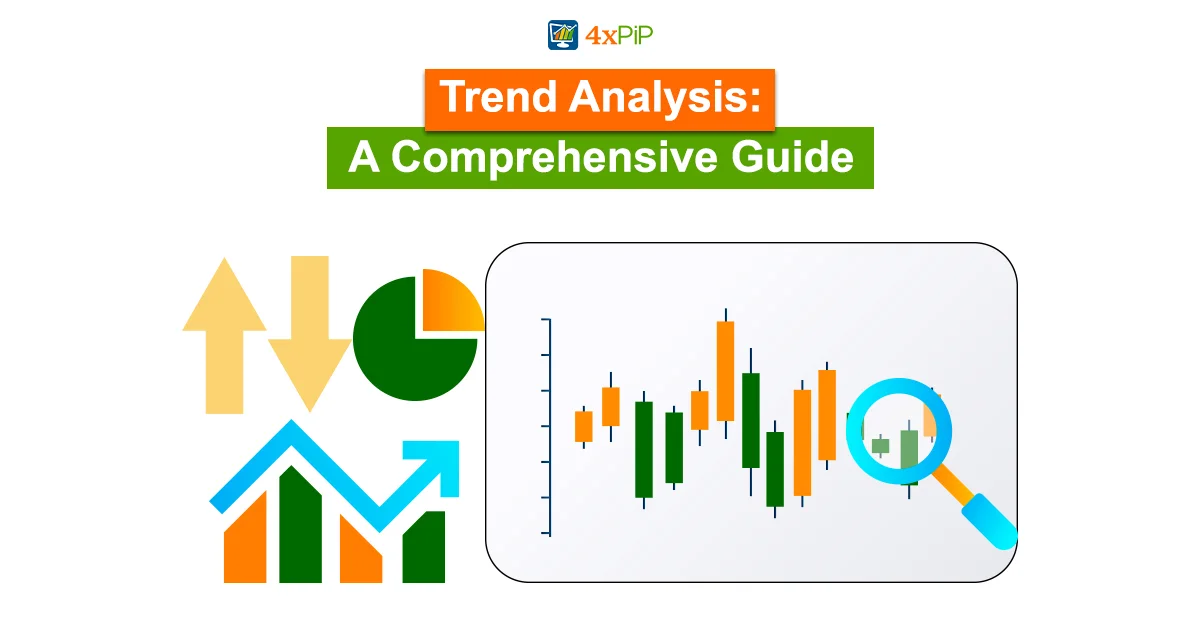Trend analysis, employing transition words, utilizes technical analysis to forecast future stock price movements by relying on recently observed trend data.
Trend analysis uses historical data, such as price movements and trade volume, to forecast the long-term direction of market sentiment. This information can then be used to make trading decisions, such as when to buy and sell stocks.
Types of Trends:
There are three main types of trends: uptrends, downtrends, and sideways trends.
Uptrends:
Uptrends occur when the price of a security is making higher highs and higher lows. They are generally considered to be bullish, meaning that the market is expecting higher prices in the future.
Downtrends:
Downtrends occur when the price of a security is making lower highs and lower lows. They are generally considered to be bearish, meaning that the market is expecting lower prices in the future.
Sideways trends:
Sideway trends occur when the price of a security is moving in a range, with no clear upward or downward direction. Sideways trends can be frustrating for traders, but they can also be a good time to consolidate positions and wait for a breakout in either direction.
Identifying Trends:
There are several different ways to identify trends. Some of the most common methods include:
Trendlines:
Traders simply draw trendlines on a chart to connect the highs and lows of a trend. They draw uptrend lines above the price action and downtrend lines below the price action. Once traders draw a trendline, they can use it to identify potential support and resistance levels.
Moving averages:
The 50-day, 100-day, and 200-day moving averages are popular technical indicators used to smooth out price data and identify trends. Traders can calculate them by averaging the price of a security over a specific period.
Other technical indicators:
Traders can use several technical indicators, including the MACD, RSI, and Bollinger Bands, to identify trends. These indicators confirm existing trends or signal potential trend reversals.
Trading Trends:
Once a trend has been identified, traders can use it to make trading decisions. For example, a trader who identifies an uptrend in a stock may decide to buy the stock in anticipation of higher prices in the future. Conversely, a trader who identifies a downtrend in a stock may decide to sell the stock or short it in anticipation of lower prices in the future.
It is important to note that trend analysis is not a perfect science. There is no guarantee that a trend will continue indefinitely. Trends can reverse at any time, and it is important to be aware of the risks involved in trading trends.
Trend Trading Strategies:
Trend trading is a trading strategy that attempts to profit from the movement of prices in a particular direction. Identify trends and then buy securities that are trending upwards and sell securities that are trending downwards. There are many different trend trading strategies, but some of the most common include:
Moving averages:
A popular technical indicator that can help identify trends is the calculation of moving averages, which involves taking the average price of a security over a certain period. Trend traders often use moving averages to generate trading signals. For example, a trader may buy a security when its price crosses above its 50-day moving average and sell it when its price crosses below its 50-day moving average.
Momentum indicators:
Momentum indicators measure the rate of change in prices. Trend traders often use momentum indicators to identify stocks that are trending strongly and to generate trading signals. For example, a trader may buy a security when its RSI (relative strength index) is above 70 and sell it when its RSI is below 30.
Trendlines and chart patterns:
Trendlines are simply lines drawn on a chart to connect the highs and lows of a trend. Chart patterns are recurring formations in price charts that can be used to identify trends and potential reversals. Trend traders often use trendlines and chart patterns to generate trading signals. For example, a trader may buy a security when it breaks out above a trendline resistance level or sell it when it breaks out below a trendline support level.
It is important to note that no trend trading strategy is perfect. All trend trading strategies have the potential to lose money. It is also important to remember that trends can reverse at any time, so it is important to have a risk management plan in place.
Benefits of Trend Analysis:
- Identify trading opportunities: Trend analysis can help traders to identify potential trading opportunities by identifying trends in the market. Once a trend has been identified, traders can look for ways to trade in the direction of the trend.
- Manage risk: Trend analysis can also help traders to manage risk. For example, a trader who identifies an uptrend may be willing to risk more money on a trade because they believe that the trend is likely to continue. Conversely, a trader who identifies a downtrend may be more cautious and may risk less money on a trade.
- Make more informed trading decisions: Trend analysis can help traders make more informed trading decisions by providing them with insights into the direction of the market and the potential risks and rewards of different trading strategies.
- Understand the market: Trend analysis can help investors and traders to better understand the factors that are driving trends in the market. Investors can use this information to make more informed investment decisions and to develop better trading strategies.
To prepare a trend analysis, traders can follow these steps:
- Identify the security or market to analyze. This could be a specific stock, bond, currency, commodity, or other financial instrument, or it could be a broader market index or sector.
- Gather the data. This may involve accessing financial statements, downloading market data, or accessing databases or other sources of data.
- Organize the data. This may involve creating spreadsheets, charts, or graphs to visualize the data.
- Analyze the data. This could involve looking for patterns in the data, calculating statistical measures such as averages or standard deviations, or using graphical tools such as charts to identify trends.
- Interpret the results. This involves determining what the trends identified in the data mean for trading decisions. This could involve making predictions direction of the security or market, identifying risks or opportunities, or making recommendations for buying, selling, or holding the security.
- Use the results to inform trading decisions. Traders can use the insights gained from their trend analysis to inform their trading decisions. This could involve adjusting their portfolio, placing trades, or making other decisions based on the trends they have identified.
Mastering Trend Analysis: A Comprehensive Guide for Informed Trading:
Trend analysis is a pivotal technique in the arsenal of any trader; additionally, leveraging historical data to predict future stock price movements is crucial. This comprehensive guide explores the nuances of trend analysis; moreover, it offers insights into its types, identification methods, and trading strategies. From uptrends and downtrends to sideways trends, understanding these patterns equips traders with the foresight needed to navigate the dynamic market. Techniques like trendlines, moving averages, and various technical indicators are demystified; furthermore, this empowers traders to make informed decisions.
Navigating Trends: A Practical Insight into Mastering Trend Analysis with 4xPip’s Expertise:
Navigating the complex world of trading requires mastering trend analysis; additionally, a powerful tool for predicting future market movements. This guide provides a clear roadmap, breaking down the intricacies of uptrends, downtrends, and sideways trends. Through methods like trendlines and moving averages, traders can identify potential support and resistance levels; moreover, thus enhancing their ability to time buying and selling decisions. However, it’s crucial to acknowledge that no strategy is foolproof, and trends can reverse unexpectedly. 4xPip, a leader in trading education, complements this guide with cutting-edge tools and resources. Furthermore, it offers traders the knowledge and tools they need to stay ahead in the ever-evolving market. Elevate your trading game with 4xPip’s commitment to education and innovation. For more information, contact 4xPip’s customer support at [email protected].
Summary:
With the help of this thorough guide, set out to master trend analysis. Additionally, traders obtain invaluable insights to maneuver the ever-changing market, ranging from comprehending diverse trend types to utilizing an array of identification techniques and trading strategies. Moreover, the guide explores the benefits and drawbacks of trend analysis with an emphasis on making well-informed decisions, stressing the importance of taking a balanced approach. Furthermore, with the backing of 4xPip‘s experience, this guide gives traders the know-how and resources they need to improve their trading.
FAQ’s
How does trend analysis benefit traders in identifying trading opportunities?
Trend analysis helps spot potential trading opportunities by recognizing market trends.
What are the primary advantages of managing risk through trend analysis?
Traders can better manage risk by adjusting their strategies based on identified uptrends or downtrends.
How can trendlines and moving averages be used effectively in trend trading?
Trendlines and moving averages assist in generating signals and identifying potential support and resistance levels.
What precautions should traders take given the imperfections of trend analysis?
Traders should be cautious as trends can reverse unexpectedly and should have a risk management plan.
Should trading decisions be made solely relying on trend analysis?
No, trend analysis should be part of a comprehensive strategy, considering other factors like fundamental analysis.
How does 4xPip support trend analysis with its educational resources and tools?
4xPip complements the guide with cutting-edge tools and resources, enhancing traders’ knowledge and skills.
What are key considerations when interpreting trends for trading decisions?
Traders should interpret trends by predicting future market direction, identifying risks, and evaluating opportunities.
How does trend analysis contribute to a trader’s understanding of market dynamics?
Trend analysis provides insights into factors driving market trends, aiding traders in making informed decisions.
What role do technical indicators like MACD, RSI, and Bollinger Bands play in trend analysis?
These indicators confirm trends or signal potential reversals, adding depth to trend analysis.
In what ways does 4xPip innovate in trading education to empower traders?
4xPip innovates by offering cutting-edge tools and educational resources, keeping traders ahead in the market.












